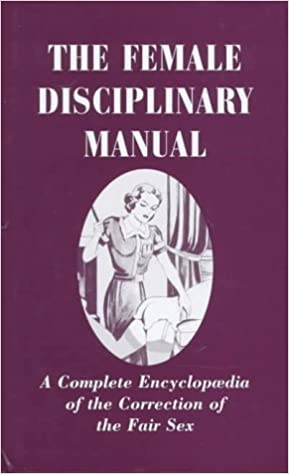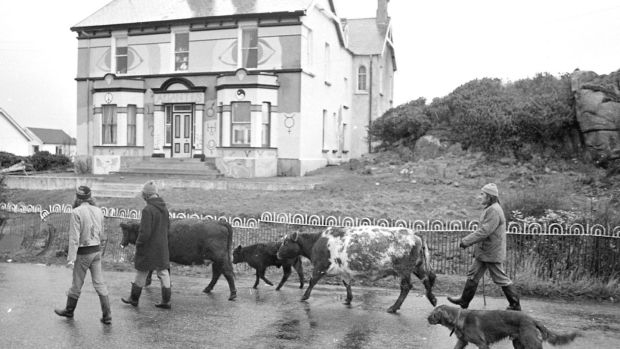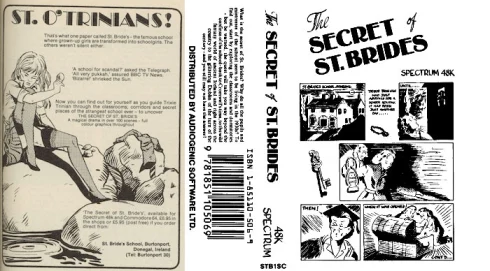A few months ago, I perused the used books section at Vancouver’s venerable queer bookstore Little Sisters. In addition to a book on Kenneth Anger’s underground gay leather film Scorpio Rising, I happened across a book without a barcode or copyright date or even an author, titled The Female Disciplinary Manual. I had heard of this before and remembered something about it being connected with some kind of schoolgirl discipline fantasy operation. As it was only $9.00 Canadian and in excellent condition with dust jacket (copies on Amazon are priced at $148 or more), I snapped it up.
The book itself is a rather odd work, purporting to be from the 2030s when the school disciplinary regime of the early 20th century in England has been reinstated as the solution to a decadent culture. The prose is in an arch, deadpan tone that leaves the reader guessing how much of this is part of the school discipline fantasy and how much is sincere.
By happenstance, I also came across the strange story of the organization that wrote and published the book and apparently lived by its ethos. The fifty-year saga links into pagan cults, lesbian separatists, Victorian-Edwardian cosplay as a lifestyle, early text-only video games, the English schoolgirl-discipline fetish, and far-right politics.
Teasing out the exact story behind the creation of The Female Disciplinary Manual is not easy. It involves a number of people who use and share various aliases and alternate personae and ideologies in a conscious act of self-mythologization. What follows draws on articles published on Skag magazine and Fifty Years of Text Games on Substack.
In Oxford, 1971, a radical student group came together that combined feminist separatism with cultural conservatism, plus a pagan matriarchal religion called Lux Madriana and an elaborate fantasy world called Aristasia.
Much like the rich fantasy worlds created by Tolkien or the Brontë sisters, Aristasia became an ever-growing obsession for its creators, with its own customs, calendar, literature, and history, to the extent that some of the worldbuilders eventually dropped out of university to attend their own unofficial Aristasian school instead. In Aristasia there were two genders, both female (assertive brunettes and demure blondes); the decadent modern world was known as The Pit; and the word for person was not man but maid.
Source
Some of this group settled in a house in the Irish coastal village of Burtonport, and called themselves the Rhennish folk, or “Silver Sisterhood”. A few years later, something shifted, and a different group of people occupied the house and called themselves St. Bride’s School.
St. Bride’s billed itself as something between a real school and a holiday retreat, posting ads for week-long terms where students would “spend 24 hours a day living in a different time, living a different life.” The staff and students observed a strict hierarchy, with obedient students appointed prefects to keep the others in line, and prefects reporting in turn to teachers: “Some maids like to tell others what to do,” as a visitor summarized the philosophy during the Silver Sisterhood days, “and some maids like to be told what to do.” Both the Sisterhood and St. Bride’s attracted copious media attention—which seems likely to have been deliberately sought out—and from news clips it’s clear at least some residents of both groups were the same people, though going by different names and speaking with changed accents.
Source
In the St. Bride’s phase, many different people had many different names and personae. “Miss Regina Snow” and “Miss Marianne Martindale”, authors of other books published by this group, appeared to have been shared identities, with different people making public appearances under the same name.
Ultimately, the women of St Bride’s needed to raise money to fund this peculiar lifestyle. Their primary source of income was providing a boarding school experience to young ladies, a role-playing getaway where visitors could experience a trip to the past and a return to good old fashioned morality. As the years went by, the focus on corporal punishment — in particular the use of caning — grew to the point where the group was described as a fetish club. For the eight years of its existence, St. Bride’s toed the line between an idealistic escape from modern depravity and a house of masochistic cosplay enthusiasts. Reading the writings of Clare Tyrell, the word discipline appears to be at the forefront of her mind. Somewhere behind the lace and crinolines, the maids of St Bride’s appeared to derive a lot of pleasure from inflicting pain onto others.
Source
Another peculiar twist is that while St. Bride’s fetishized the pre-WWII past, it also pioneered early text-based computer games, driven by “Miss Priscilla Langridge”. Whether this was an actual person or another shared identity is unclear. There is some evidence this personae was actually a trans woman, not something common in 1980s Ireland.
The text game The Secret of St. Bride’s was sold via direct mail ads in video game magazines, putting the player back in a girls school in the 1920s. A commercial and critical success, Langridge followed up with more, including the much-delayed fantasy Silverwolf, with a companion comic strip, also by Langridge, based on a fiction serial that drew on Aristasian lore in the lesbian periodical Artemis (apparently also published by the same group under other names). The magic of the game is full of transformations and mergings. Other games included 1987’s Jack the Ripper, with low-res but lurid graphics that made it the first game given an 18 certificate by the British Board of Film Classification.
The games […] turn out to have been part of a wider business portfolio that also included handmade costumes (“silk, satin and lace dresses, styles from 1800 to 1940, also maidservants’ uniforms” ran a small ad) and a publishing house, The Wildfire Club, through which the school published lesbian periodicals (Artemis, The Romantic and others) and books by Martindale such as The District Governess and The Female Disciplinary Manual.
Source
It’s here that we come to the crux of what was going on at St Bride’s. Was it an innocuous institution for role-playing eccentrics, or was there something more fetishistic in its make-up? The answer appears to be both. On the one hand, it was a sort of “romantic retreat where 19th century values, politeness and dressmaking were preferred to the tawdry modern world”, but in investigating St Bride’s and its subsequent iterations, the word “discipline” comes up a lot. In the early ‘90s, before the school eventually closed, Martindale was convicted of caning a pupil rather more enthusiastically than the recipient would have liked.
Source
In 1990, a woman named Mari De Colwyn (likely Scarlett) was convicted of “actual bodily harm” for caning an adult St. Bride’s student: “she had done a very naughty thing,” the former headmistress offered by way of explanation. The ladies eventually abandoned the house; its owners, seeking their unpaid rent, broke in one night and leaked a story to the media that the place had been filled with “material produced by neo-Nazi organizations and the sado-masochistic sex industry,” as well as correspondence with far-right organizations like Britain’s virulently racist National Front.
Source
…uncomfortable echoes of far-right thinking had been present in the St. Bride’s ethos from the start, from a focus on discipline and a “proper place” for everyone to a yearning for an earlier, “purer” time. Some of these notions had been inspired in part by readings in the Oxford days of anti-modernist philosopher Guenon, whose ideas would also resonate for people like Richard Spencer and Steve Bannon. Regardless of what the truth was, the school’s reputation had forever changed from strange to sinister, and tabloids would repeatedly characterize its members as Nazis and lesbian sex fiends through the rest of the 1990s.
Source
In the 1990s, the group relocated to London and rebranded as Aristasia. This is when the books were published. Trying to pin down the group’s identity remained frustrating: was it a clique of harmless eccentrics, an elaborate front to publicize and cover for a professional domination operation, or something more sinister?
…some of the school’s pupils in later years would come to characterize the group as dangerously earnest, with one describing it as a cult. “There was something sinister at the heart of it,” she wrote: “The founder was a remarkable person but was leading a fantasy life—we were living in someone else’s fantasy.” While much about the Games Mistresses would shift across their decades of fronts and personas, disconnection from the everyday world was a constant theme.
Source
…Martindale’s sidetracking Aristasia into an overemphasis on fetish (whether she admitted that was what it was or not) seems to have annoyed many of her peers until she was effectively “silenced”.
Source
I won’t go into the rumors concerning the later lives of “Martindale” and “Langdrige”.
The whole St. Bride’s/Aristasia thing reminds me a bit of John Norman’s Gor books, which also sit uncomfortably between erotic fantasy and retrograde politics, and exerts an uncanny pull on certain people to the point of constructing a lifestyle. You can see similar patterns in, for example, the “Final Fantasy House” micro-cult.
RTE.ie has a 6-minute video from 1984 of the St. Bride’s house in its heyday in Burtonport, which links to other articles and videos on the group. A number of other videos can be found on Youtube by searching for “Aristasia”.








A fair amount of Aristasia material can be found on archive.org. I particularly recommend “The Feminine Regime.” Note that two versions of the latter are circulating on the internet: a partial and a complete version.